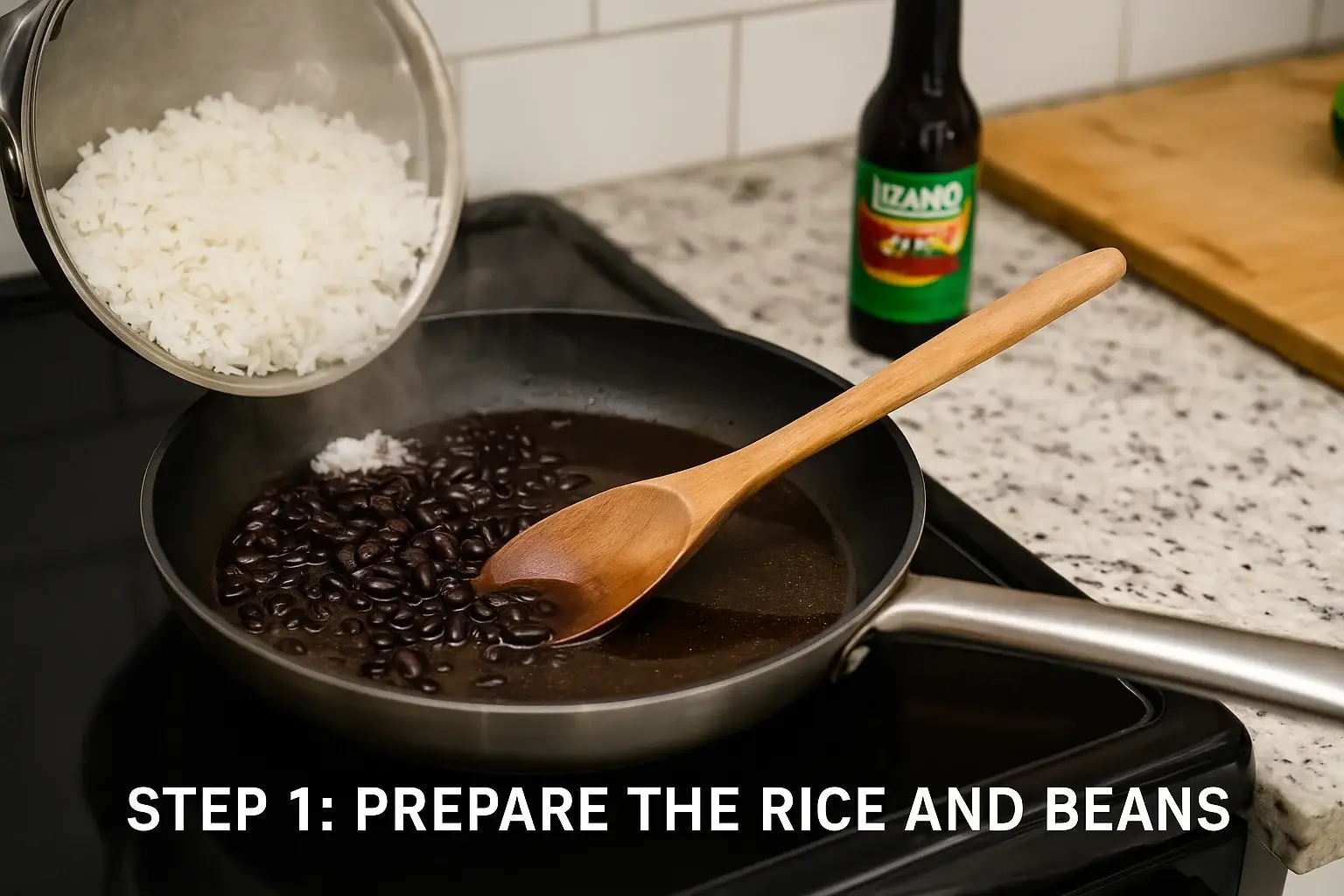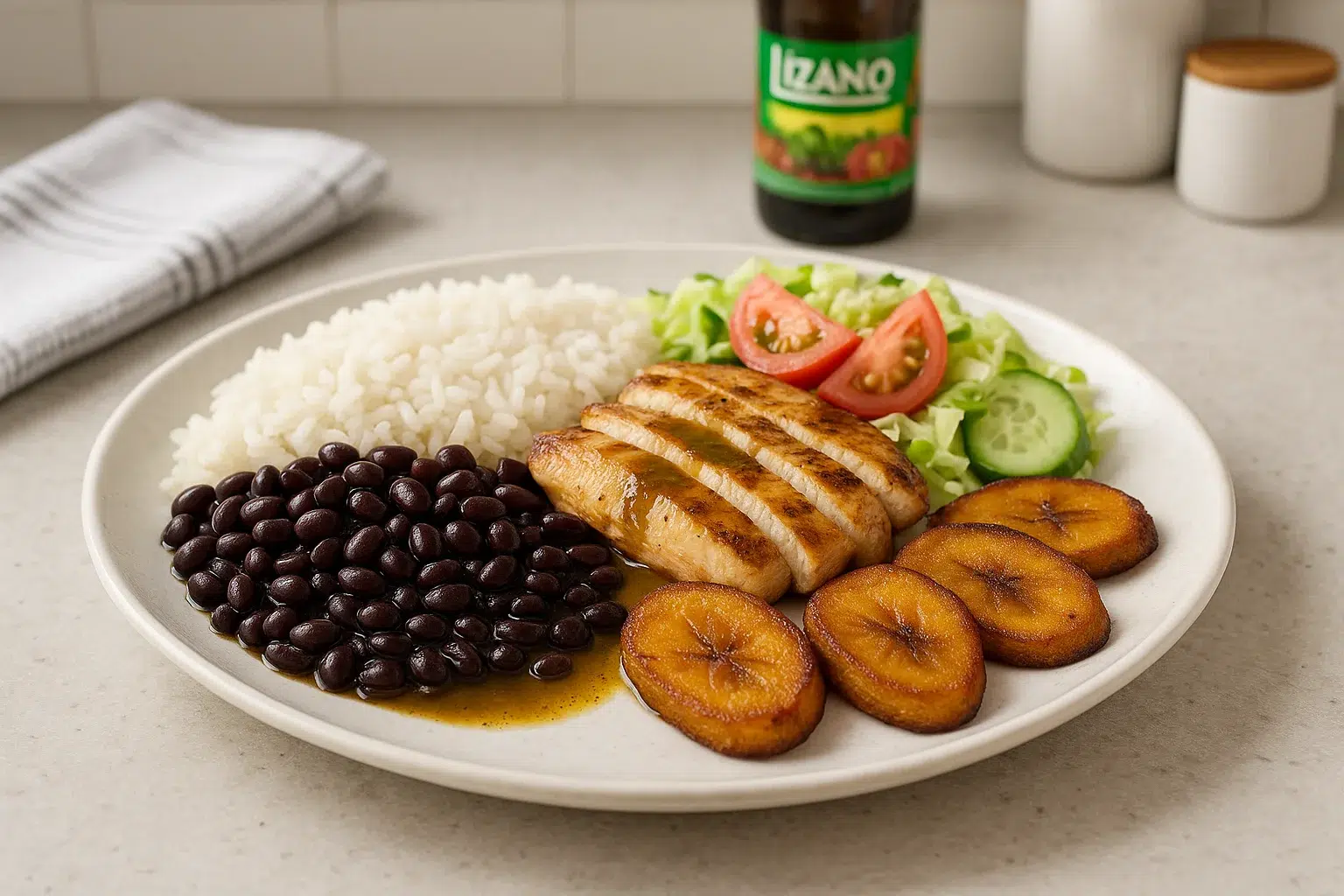Casado (Traditional Mixed Plate) – The Heart of Costa Rican Home Cooking
The first time I plated a Casado in my own kitchen, it felt like I had captured the spirit of Costa Rica on one plate.
Warm rice, tender black beans, sweet plantains, a crisp salad, and perfectly grilled meat — it’s not just food. It’s comfort, color, and balance all in one bite.
In Costa Rica, Casado is more than a meal. Locals call it “the married plate” because it brings together everything you need for a satisfying, home-cooked lunch or dinner. It’s served in small family cafés, busy roadside sodas, and homes where cooking is an act of love.
What makes this dish special is its simplicity. No complicated techniques. No rare ingredients. Just honest, fresh food that anyone can cook. And after more than 10 years in the kitchen, I can tell you this: a well-made Casado can win over any guest at your table.
If you’re new to Costa Rican cooking, start here — and for more inspiration, explore my other Costa Rican easy recipes.
What is Casado?
Casado is a traditional Costa Rican mixed plate meal that combines rice, beans, plantains, salad, and a choice of protein into one balanced, satisfying dish.
The word casado means “married” in Spanish — a nod to how these different foods come together on a single plate. In Costa Rica, it’s a go-to lunch or dinner served in homes, cafés, and roadside eateries called sodas.
A classic Casado usually includes:
-
Steamed white rice – fluffy and neutral, perfect for soaking up flavors
-
Black beans – slow-cooked for richness and depth
-
Fried or grilled plantains – sweet if ripe (maduros), savory if green
-
Fresh salad – cabbage, tomato, cucumber, and a light dressing
-
Grilled protein – chicken, beef, fish, or eggs for a vegetarian twist
This combination delivers color, flavor, and nutrition in every bite. And after years in the kitchen, I’ve learned that while the components are simple, the harmony they create is unforgettable.
Ingredients You’ll Need

After years in the kitchen, I’ve learned that Casado isn’t about stuffing your plate with endless extras — it’s about getting the core right. If these basics are on point, you’ve already won half the battle.
Here’s my short and honest list — the same essentials I use when I want a Casado that tastes like it came straight from a Costa Rican home:
If you want to get playful — maybe add avocado, fresh cheese, or grilled veggies — go for it. And if you’re wondering what else pairs beautifully, just ask Google… or even ask ChatGPT and I’ll walk you through exactly how I’d do it.
Step-by-Step Casado Recipe
Cooking a Casado isn’t about chasing perfection — it’s about putting together a plate that feels warm, inviting, and full of life. I’ve made it on lazy Sunday afternoons, and I’ve also rushed through it on weeknights when friends dropped by unannounced. Either way, it always works.
The process is simple: prepare each element separately, give it the attention it deserves, and then bring them together on one plate. The rice and beans are your steady base. The protein brings depth. The plantains and salad? They’re the fun, colorful accents that make people smile before the first bite.
Think of it as layering flavors and textures rather than “following a recipe.” Once you see how it all comes together, you’ll understand why this dish is a Costa Rican classic — and why it never fails to impress at my table.
Step-1: Prepare the Rice and Beans

I always start with the rice and beans — they set the mood for the whole plate. If the base is good, the rest of the Casado practically builds itself.
For the rice:
-
I prefer day-old rice — it holds shape better and soaks up flavor beautifully.
-
Reheat gently in a steamer or with a splash of water in a covered pan.
-
Keep the grains fluffy, not mushy.
For the beans:
-
Warm them slowly with a bit of their cooking liquid (or water if using canned).
-
Add 1 spoon of Lizano sauce if you have it — the aroma says “Costa Rica” instantly.
-
Season lightly with salt and pepper; don’t overdo it.
💡 Chef’s note: Take your time here. Slow heat lets the flavors bloom, and that’s what makes this base irresistible.
By the time the rice and beans are ready, your kitchen will smell like comfort. Honestly, I could eat them just like this with a fried egg on top — but we’ve got more coming for the plate.
Step-2: Cook the Protein

The protein is the heart of a Casado. It’s what makes the plate feel substantial and satisfying.
Choose your protein:
-
Chicken breast – lean, tender, and quick to cook
-
Beef steak – bold flavor and hearty texture
-
Fish fillet – light, fresh, and perfect for warm days
My cooking method:
-
Season simply with salt, pepper, and a touch of oil.
-
Grill or pan-sear until cooked through but still juicy.
-
Let it rest for 1–2 minutes before slicing — it keeps all those delicious juices inside.
💡 Chef’s note: Good protein doesn’t need heavy seasoning. I’ve impressed guests with nothing more than a pinch of salt, a hot pan, and the confidence not to overcook it.
Once the protein is done, keep it warm — we’ll need it ready for the final plate assembly.
Step-3: Fry or Grill the Plantains

Plantains are the personality of a Casado. Sweet if ripe (maduros), savory if green — they add that little surprise to every bite.
Pick your style:
-
Ripe plantains – soft, sweet, caramelized edges
-
Green plantains – firm, slightly starchy, with a savory bite
How I cook them:
-
Slice evenly so they cook at the same pace.
-
For frying: heat a thin layer of oil and cook until golden on both sides.
-
For grilling: brush lightly with oil and grill until they get char marks.
-
Drain fried plantains on a paper towel to keep them crisp.
💡 Chef’s note: I often fry a few extra because at least one disappears before it reaches the plate. It’s a hazard of cooking in my kitchen.
Once the plantains are ready, we can move on to the final — and my favorite — step: putting it all together.
Step-4: Assemble the Plate

This is my favorite part — where all the work comes together into one inviting plate. Presentation matters here, because we eat with our eyes first.
How I plate a Casado:
-
Start with a generous scoop of rice on one side.
-
Place the beans right next to it so their juices just kiss the rice.
-
Add your protein front and center — make it the star.
-
Tuck the plantains along one edge for a pop of golden color.
-
Finish with a fresh salad for crunch and brightness.
Final touch:
-
Drizzle a spoon of Lizano sauce over the protein or keep it on the side for dipping.
💡 Chef’s note: When I serve Casado to friends, I watch them pause for a second before eating — that moment when they’re deciding which bite to take first. That’s when I know I’ve done it right.
My Pro Tips for the Perfect Casado
After more than 10 years in the kitchen, I’ve learned that it’s the little details that turn a good Casado into a great one. These tips come from cooking it for friends, family, and even for big gatherings where the plate needed to wow everyone at the table.
1. Respect the order of cooking
Start with rice and beans so the flavors have time to develop. While they simmer, you can prepare the protein and salad.
2. Don’t overcrowd your pan
Especially when searing protein — give it space so it browns beautifully instead of steaming.
3. Keep your plantains fresh until the last minute
Fry or grill them just before serving so they stay crisp on the outside and tender inside.
4. Play with your sides
While Casado is traditionally served with salad and plantains, I sometimes swap the salad for a warm bean side like my Cuban garbanzo stew — it adds a rich, comforting twist.
5. Make it your own
Whether it’s adding avocado, a sprinkle of fresh cheese, or switching proteins, Casado is meant to adapt to your tastes.
💡 Chef’s note: I still remember serving Casado at a small dinner party. One friend put down his fork, looked at me, and said, “Eric, you’ve outdone yourself this time.” That’s the magic this dish can bring to your table.
Serving Suggestions
One of the things I love about Casado is how versatile it is — you can serve it as a simple weekday dinner or dress it up for guests and it still feels authentic.
When to serve it:
-
Lunch – the traditional choice in Costa Rica
-
Dinner – hearty enough to be the main event
-
Meal prep – components store well for quick assembly later
Pairing ideas:
-
Drink: fresh tropical juice or strong Costa Rican coffee
-
Bread: soft, slightly sweet Belizean powder buns
-
Dessert: a batch of my sourdough sugar cookies for a cozy, homemade finish
💡 Chef’s note: I often serve Casado family-style — rice in one bowl, beans in another, meat sliced on a platter. Everyone builds their own plate, and somehow, every plate looks different. That’s part of the charm.
Variations You Can Try
One of the joys of Casado is that it’s flexible — the basic structure stays the same, but you can adjust it to fit your taste, dietary needs, or whatever’s in your fridge. I’ve done all of these at one time or another, and each one still feels like a true Casado.
Go vegetarian
-
Swap the meat for grilled zucchini, mushrooms, or eggplant.
-
Add a fried egg or two for extra protein.
Change the beans
-
Try red beans or even lentils for a different flavor profile.
-
Make a quick refried version if you like a creamier texture.
Play with the plantains
-
Use ripe for sweetness or green for a savory edge.
-
Grill them for a lighter option with a smoky note.
Switch the protein
-
Chicken for a lean choice, beef for something heartier, or fish for a light and fresh plate.
💡 Chef’s note: Once, I served a fully vegetarian Casado at a potluck without telling anyone — the grilled veggie “steak” fooled three people into thinking it was beef. That’s the beauty of this dish: it’s all about the balance, not just one ingredient.
Why Casado is More Than Just a Meal
For me, Casado has never been just about the food. It’s a plate that carries the warmth of a Costa Rican afternoon, the sound of conversations over lunch, and the comfort of knowing everything you need is right in front of you.
I still remember eating Casado at a tiny roadside soda in Alajuela. The plate was simple — nothing fancy, no modern plating tricks — but the flavors were honest. The owner served it with a smile that felt like an invitation to stay a little longer. That’s when I understood: Casado isn’t just nourishment, it’s hospitality.
Cooking it at home brings that same feeling to my own table. It’s the kind of meal where people pause to talk between bites, where no one is in a rush, and where you might just share a story or two without even thinking about it.
FAQs About Casado
1. What does “Casado” mean in Costa Rican cuisine?
Casado means “married” in Spanish, describing how rice, beans, plantains, salad, and protein are “married” together on one plate.
2. Why is Casado considered a complete meal?
It’s considered complete because it combines carbs (rice), protein (meat or eggs), fiber (beans), fresh vegetables (salad), and a sweet or savory side (plantains).
3. When is Casado typically eaten in Costa Rica?
Casado is most often eaten at lunchtime, the main meal of the day in Costa Rica.
4. Can Casado include different side dishes?
Yes. Extras like fried eggs, avocado, cheese, pasta salad, tortillas, or cooked vegetables (picadillo) are sometimes added.
5. Is Casado a healthy and affordable dish?
Yes. It offers a balanced mix of nutrients and is budget-friendly, which is why it’s a popular everyday meal in Costa Rica.
Final Thoughts
Every time I make a Casado, I’m reminded that great cooking doesn’t have to be complicated. With just a few honest ingredients, you can create a plate that’s colorful, balanced, and deeply satisfying.
For me, it’s more than a recipe — it’s a little piece of Costa Rica I can share with anyone who sits at my table. Whether it’s lunch on a quiet day or a lively dinner with friends, Casado always feels like the right choice.
If this is your first time making it, follow the steps, trust your taste, and don’t be afraid to add your own twist. That’s how food traditions stay alive — they adapt while keeping their heart.
And if you’re ready to keep exploring these flavors, you’ll find more inspiration in my collection of Costa Rican easy recipes. Who knows? Your next favorite meal might be just a plate away.

Casado (Traditional Mixed Plate) – The Heart of Costa Rican Home Cooking
Equipment
- Frying pan or grill pan
- Medium pot (for rice)
- Small pot (for beans)
- Tongs
- Cutting board + Knife
Ingredients
- 1 cup cooked white rice
- 1 cup cooked black beans
- ½ ripe green plantain (sliced)
- 1 serving serving (150–200 g) grilled protein (chicken, beef, or fish)
- 1 cup fresh salad (cabbage, tomato, cucumber)
- 1-2 tbsp Lizano sauce
- to taste Salt and pepper to taste
- 1 cup Cooking oil for frying/grilling
Instructions
Prepare the Rice and Beans:
- Reheat day-old rice in a steamer or with a splash of water in a covered pan until fluffy.
- Warm beans slowly with a bit of their cooking liquid. Add Lizano sauce, season lightly, and keep warm.
Cook the Protein:
- Season protein with salt, pepper, and a little oil.
- Grill or pan-sear until cooked through and juicy. Rest for 1–2 minutes before slicing.
Fry or Grill the Plantains:
- Slice evenly. Fry in a thin layer of oil until golden, or grill with light oil until char marks appear.
- Drain fried plantains on paper towels.
Assemble the Plate:
- Place rice on one side of the plate, beans next to it, protein in the center, plantains along the edge, and salad on the side.
- Drizzle Lizano sauce over protein or serve on the side.

